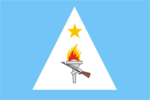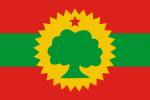Flag of Ethiopia
| Flag of Ethiopia | |
|---|---|
 |
|
| Vexillological symbol : |
|
| Aspect ratio: | 1: 2 |
| Officially accepted: | February 6, 1996 changed August 28, 2009 |
The flag of Ethiopia with the current national emblem was officially introduced on February 6, 1996 and changed slightly on August 28, 2009. Their basic tricolor was used as early as the 19th century and is the origin of the Pan-African colors .
meaning
The colors are interpreted differently. The official symbolism is:
- Green stands for the fertility of the country's earth.
- Yellow stands for love for the motherland.
- Red stands for strength and is a reminder of the blood that was shed in the fight against the oppressors.
At the same time, the colors represent the most important parts of the country:
In the Empire the following meaning was ascribed to the colors:
- Green was the symbol of the country
- Yellow represented the church, peace, and natural wealth
- Red was the color of the patriots' strength and blood
Further interpretations are assigned to the religious area.
- One of them relates to the Christian Trinity and Christian virtues. Then it says
- Green for the Holy Spirit and hope
- Yellow for God the Father and charity
- Red for God's Son and faith
- In the belief of the Rastafari , which u. a. is common in Shashemene , the following meanings are assigned to the colors, in reverse order:
- Red for the bloodshed and the murders of the abducted slaves,
- Gold for the wealth that was stolen from the slaves ( Sufferahs , "sufferers"),
- Green for the promised motherland Ethiopia or Africa in general, which awaits the homecoming of the displaced.
The emblem in the middle stripe of the flag shows a shining pentagram with "rays" of equal length. This symbolizes the equality of all ethnic groups as well as gender and belief. The rays represent a bright future for Ethiopia, the blue background represents peace and democracy .
history
The flag probably originated from the union of three separate pennants in the colors green, yellow and red, popular in Ethiopia, and was first introduced on October 6, 1897. The empire showed a lion with a cross staff and a banner in the national colors, the so-called lions of Judas or imperial lions . Tricolors without a lion were also used. The flag then had an aspect ratio of 2: 3. The tricolors of France and Italy were probably the model for the arrangement of three stripes. Between 1936 and 1941, Ethiopia was occupied by Italy and in May 1941 the Ethiopian flag was re-used. During the Italian occupation this flag became a banner of freedom.
In 1975 the imperial lion disappeared from the flag, along with the empire. In 1987 the aspect ratio changed to 1: 2 and the emblem of the People's Democratic Republic was added . In 1991 the tricolor without an emblem was reintroduced and the new aspect ratio remained. This flag is still widely used today. In 1996, a new emblem was added to the flag, which was enlarged a little in 2009.
2: 3 ? National flag of the Empire with the lion of Judas, 1897 to 1936 and 1941 to 1974

2: 3 ? National flag from 1975 to 1987


1: 2 ? Flag of Ethiopia 1987-1991

1: 2 ? National flag of the DPR, 1991-1996

1: 2 ? National flag, 1996 to August 27, 2009

State flags
1: 2 ? Flag of the Autonomous Region of Eritrea from 1950 to 1962 (unofficial until 1993)

Flags of rebel groups
literature
- Whitney Smith , Ottfried Neubecker : coats of arms and flags of all nations. Battenberg, Munich 1980, ISBN 3-87045-183-1 .
Individual evidence
- ^ Proclamation No. 654/2009 ( Memento of the original from October 18, 2011 in the Internet Archive ) Info: The archive link was inserted automatically and has not yet been checked. Please check the original and archive link according to the instructions and then remove this notice. (English)
- ^ Whitney Smith, Ottfried Neubecker: coats of arms and flags of all nations. Battenberg, Munich 1980, ISBN 3-87045-183-1 .

















